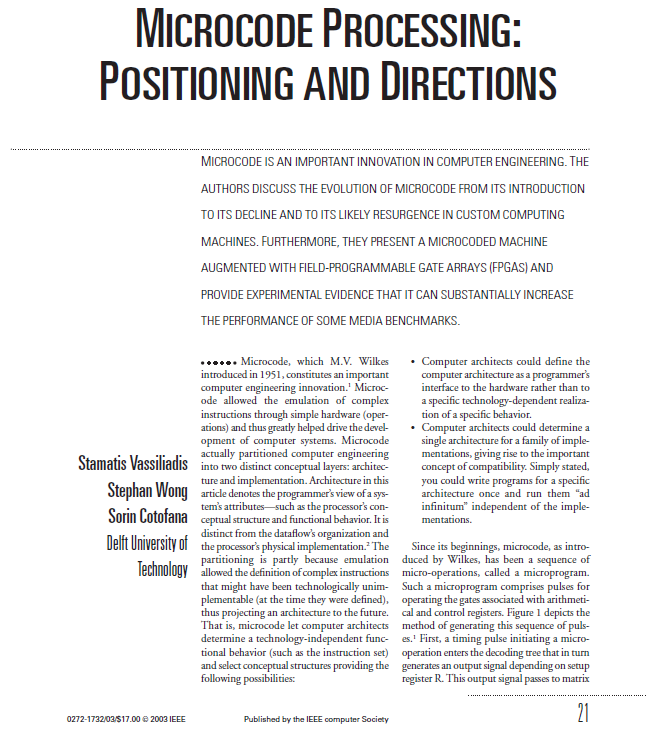Based on the given title, you are required to describe how microcode processing is used in the latest RISC-V processors
Based on the given title, you are required to describe how microcode processing is used in the latest RISC-V processors
Computer Networking: A Top-Down Approach (7th Edition)
7th Edition
ISBN:9780133594140
Author:James Kurose, Keith Ross
Publisher:James Kurose, Keith Ross
Chapter1: Computer Networks And The Internet
Section: Chapter Questions
Problem R1RQ: What is the difference between a host and an end system? List several different types of end...
Related questions
Question
Based on the given title, you are required to describe how microcode processing is used in the latest RISC-V processors?

Transcribed Image Text:MICROCODE PROCESSING:
POSITIONING AND DIRECTIONS
..............................................................
MICROCODE IS AN IMPORTANT INNOVATION IN COMPUTER ENGINEERING. THE
AUTHORS DISCUSS THE EVOLUTION OF MICROCODE FROM ITS INTRODUCTION
TO ITS DECLINE AND TO ITS LIKELY RESURGENCE IN CUSTOM COMPUTING
MACHINES. FURTHERMORE, THEY PRESENT A MICROCODED MACHINE
AUGMENTED WITH FIELD-PROGRAMMABLE GATE ARRAYS (FPGAS) AND
PROVIDE EXPERIMENTAL EVIDENCE THAT IT CAN SUBSTANTIALLY INCREASE
THE PERFORMANCE OF SOME MEDIA BENCHMARKS.
• Computer architects could define the
computer architecture as a programmer's
interface to the hardware rather than to
...... Microcode, which M.V. Wilkes
introduced in 1951, constitutes an important
computer engineering innovation.' Microc-
ode allowed the emulation of complex
instructions through simple hardware (oper-
ations) and thus greatly helped drive the devel-
opment of computer systems. Microcode
actually partitioned computer engineering
Stamatis Vassiliadis into two distinct conceptual layers: architec-
a specific technology-dependent realiza-
tion of a specific behavior.
• Computer architects could determine a
single architecture for a family of imple-
mentations, giving rise to the important
concept of compatibility. Simply stated,
you could write programs for a specific
ture and implementation. Architecture in this
Stephan Wong article denotes the programmer's view of a sys-
tem's attributes-such as the processor's con-
Sorin Cotofana ceptual structure and functional behavior. It is
distinct from the dataflow's organization and
Delft University of the processor's physical implementation. The
architecture once and run them "ad
infinitum" independent of the imple-
mentations.
Since its beginnings, microcode, as intro-
partitioning is partly because emulation duced by Wilkes, has been a sequence of
Technology allowed the definition of complex instructions micro-operations, called a microprogram.
that might have been technologically unim- Such a microprogram comprises pulses for
plementable (at the time they were defined), operating the gates associated with arithmeti-
thus projecting an architecture to the future. cal and control registers. Figure 1 depicts the
That is, microcode let computer architects
determine a technology-independent func- es.' First, a timing pulse initiating a micro-
tional behavior (such as the instruction set) operation enters the decoding tree that in turn
and select conceptual structures providing the generates an output signal depending on setup
following possibilities:
method of generating this sequence of puls-
register R. This output signal passes to matrix
.................................................................................
21
0272-1732/03/S17.00 e 2003 IEEE
Published by the IEEE computer Society
Expert Solution
This question has been solved!
Explore an expertly crafted, step-by-step solution for a thorough understanding of key concepts.
Step by step
Solved in 2 steps

Recommended textbooks for you

Computer Networking: A Top-Down Approach (7th Edi…
Computer Engineering
ISBN:
9780133594140
Author:
James Kurose, Keith Ross
Publisher:
PEARSON

Computer Organization and Design MIPS Edition, Fi…
Computer Engineering
ISBN:
9780124077263
Author:
David A. Patterson, John L. Hennessy
Publisher:
Elsevier Science

Network+ Guide to Networks (MindTap Course List)
Computer Engineering
ISBN:
9781337569330
Author:
Jill West, Tamara Dean, Jean Andrews
Publisher:
Cengage Learning

Computer Networking: A Top-Down Approach (7th Edi…
Computer Engineering
ISBN:
9780133594140
Author:
James Kurose, Keith Ross
Publisher:
PEARSON

Computer Organization and Design MIPS Edition, Fi…
Computer Engineering
ISBN:
9780124077263
Author:
David A. Patterson, John L. Hennessy
Publisher:
Elsevier Science

Network+ Guide to Networks (MindTap Course List)
Computer Engineering
ISBN:
9781337569330
Author:
Jill West, Tamara Dean, Jean Andrews
Publisher:
Cengage Learning

Concepts of Database Management
Computer Engineering
ISBN:
9781337093422
Author:
Joy L. Starks, Philip J. Pratt, Mary Z. Last
Publisher:
Cengage Learning

Prelude to Programming
Computer Engineering
ISBN:
9780133750423
Author:
VENIT, Stewart
Publisher:
Pearson Education

Sc Business Data Communications and Networking, T…
Computer Engineering
ISBN:
9781119368830
Author:
FITZGERALD
Publisher:
WILEY